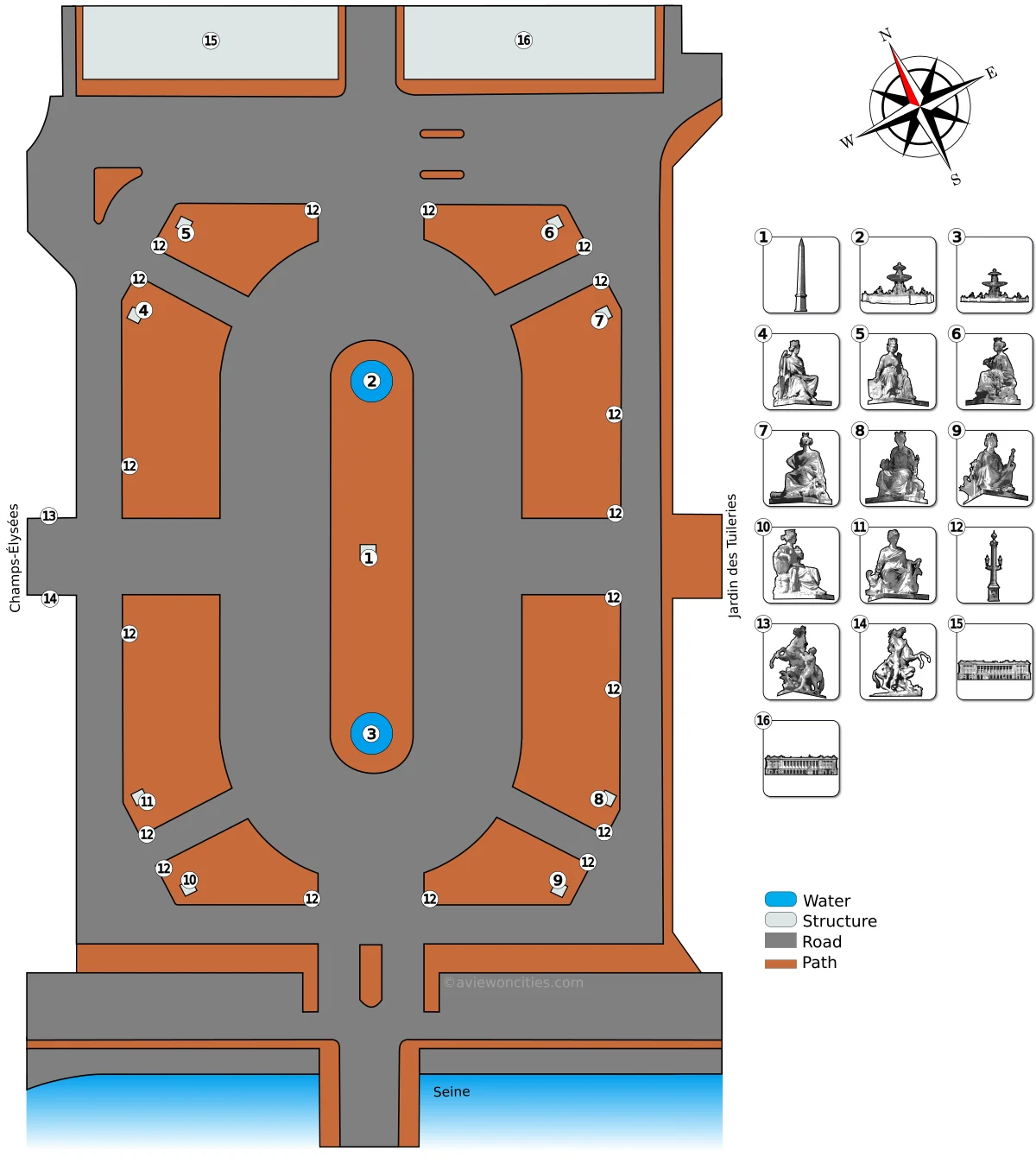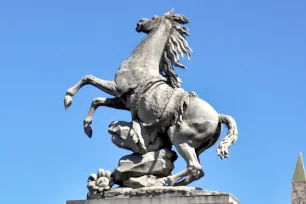At almost eight hectares (20 acres), the octagonal Place de la Concorde is the largest square in Paris. It connects the Tuileries with the Champs-Elysées. The massive square is decorated with an Egyptian obelisk and two large fountains, and is surrounded by statues and unique streetlamps.
History
Place Louis XV
The history of this square goes back to 1763, when a large statue of King Louis XV was erected at this site to celebrate the recovery of the king after a serious illness. The square surrounding the statue was created later, in 1772, by Jacques-Ange Gabriel, the principal architect of Louis XV.
Gabriel designed balustraded parterres around the central statue, and enclosed the square by wide ditches. On the eight corners of the square he built gatehouses with staircases that gave access to the square. He also built two palatial buildings on the north side of the square, which was named “Place Louis XV”.
The French Revolution and the terror of the Guillotine
In 1792, during the French Revolution, the statue of King Louis XV was replaced by a large plaster statue called «Liberté» (Liberty), and the square was renamed Place de la Révolution. A guillotine was installed at the center of the square and in a span of only a couple of years, 1119 people were beheaded here. Amongst them many famous people like King Louis XVI, Marie-Antionette, and revolutionary Robespierre, just to name a few. In 1795, the square was renamed “Place de la Concorde” as a symbol of French reconciliation.
Hittorff’s Redesign
After the revolution, the square was redesigned by Jacques Ignace Hittorff, a German-born architect, who completely revamped the square between 1833 and 1846 and gave it its current appearance. In 1836, the obelisk of Luxor was erected at the center of the square and Hittorff placed two large fountains on either side. He installed beautiful streetlamps around the perimeter of the square, and added eight large statues at each corner. The ditches around the square were filled in.
Sights
Obelisk of Luxor
In 1830 the Viceroy of Egypt offered the French King Louis Philippe two obelisks that graced the entrance to the Temple of Luxor in Thebes. Only one of these was transported to France. The voyage took a year and a half, and the 230 tonnes-weighing pink granite monolith finally arrived at the Place de la Concorde in 1833. It was raised in 1836 in the presence of Louis Philippe and some 300,000 spectators. Gilded illustrations on the pedestal describe the transportation to Paris and its installation.
The obelisk was originally built during the reign of Ramses II, around 1250 BC. Excluding its 19th-century pedestal, it reaches a height of 22.84 meters (75 feet). It is covered with hieroglyphs picturing the reign of pharaohs Ramses II & Ramses III. In 1998 a pyramidion was added to the top of the 32-centuries-old obelisk, which gave it back its appearance as it was when first installed during the reign of Ramses II. The 3.6-meter-tall pyramid-shaped tip is made of bronze plates coated with nine layers of gold.
This obelisk is the first of three that are known as «Cleopatra’s Needle» ![]() . The other two are in London (1878) and New York (1881).
. The other two are in London (1878) and New York (1881).
Statues
On the eight stone gatehouses that Jacques-Ange Gabriel had installed around the square, Hittorff placed large allegorical statues representing eight French cities: Bordeaux ![]() , Brest
, Brest ![]() , Lille
, Lille ![]() , Lyon
, Lyon ![]() , Marseille
, Marseille ![]() , Nantes
, Nantes ![]() , Rouen
, Rouen ![]() and Strasbourg
and Strasbourg ![]() . All statues show female figures who overlook the square. They symbolize national unity.
. All statues show female figures who overlook the square. They symbolize national unity.
At the entrance of the Champs-Élysées, on either side of the avenue, stand two more statues known as the Horses of Marly. They were created in 1743-1745 on order of King Louis XV by the French sculptor Guillaume Coustou and were installed at the – now demolished – palace of Marly, near Versailles. In 1795 the statues were moved to their current place on the edge of the Place de la Concorde. The statues depict feisty horses and represent America (left) ![]() and Europe (right)
and Europe (right) ![]() . The current ones are replicas, the originals are on display in the Louvre Museum.
. The current ones are replicas, the originals are on display in the Louvre Museum.
Fountains
Two monumental fountains reaching a height of nine meters (30 feet) adorn the Place de la Concorde on either side of the obelisk.
The fountain to the north of the obelisk is called the «Fontaine des Fleuves» ![]() (Fountain of the Rivers). The basin is decorated with Tritons and Nymphs holding water-spouting fish. At its center, around the pedestal, are three-meter-tall bronze statues that support a large bowl. The statues represent the Rhone River, the Rhine River, Harvest, Grape-picking, Flower-picking and Fruit-picking. Around the pedestal above, supporting the top bowl, are allegorical figures representing River Navigation, Agriculture and Industry.
(Fountain of the Rivers). The basin is decorated with Tritons and Nymphs holding water-spouting fish. At its center, around the pedestal, are three-meter-tall bronze statues that support a large bowl. The statues represent the Rhone River, the Rhine River, Harvest, Grape-picking, Flower-picking and Fruit-picking. Around the pedestal above, supporting the top bowl, are allegorical figures representing River Navigation, Agriculture and Industry.
In 1839, one year after the installation of the first fountain, Hittorff installed another, similar fountain to the south of the obelisk. This one is known as the «Fontaine des Mers» ![]() (Fountain of the Seas). The large statues supporting the first bowl represent the Ocean, the Mediterranean, Fishing, Pearling, Shell fishing, and Coral Reef Fishing. Supporting the top bowl are three more statues that symbolize Maritime Navigation, Commerce and Astronomy. Statues of dolphins, swans, Nymphs and Tritons adorn the basin.
(Fountain of the Seas). The large statues supporting the first bowl represent the Ocean, the Mediterranean, Fishing, Pearling, Shell fishing, and Coral Reef Fishing. Supporting the top bowl are three more statues that symbolize Maritime Navigation, Commerce and Astronomy. Statues of dolphins, swans, Nymphs and Tritons adorn the basin.
Rostral streetlamps
Around the Place de la Concorde are eighteen magnificent streetlamps, designed and placed on elegant pedestals by Hittorff in 1837. They are known as «Colonnes rostrales à réverbères» or Rostral column streetlamps ![]() . Rostral columns were traditionally built to celebrate naval victories, and are decorated with bows of ships. This maritime theme is a reference to the Hôtel de la Marine, which had been the home of the Ministry of the Navy since 1789.
. Rostral columns were traditionally built to celebrate naval victories, and are decorated with bows of ships. This maritime theme is a reference to the Hôtel de la Marine, which had been the home of the Ministry of the Navy since 1789.
Hôtels
To the north, the Place de la Concorde is bordered by two symmetrical buildings that feature large porticoes with twelve Corinthian columns. Both were completed in 1775 after a design by Jacques-Ange Gabriel.
The building on the right is the Hôtel de la Marine ![]() . It was originally used as the ‘Garde-Meuble’, the place where furniture from the royal palaces was stored and repaired. In 1789, as a result of the French Revolution, all the French ministries were forced to move from Versailles to Paris. The Ministry of the Navy decided to move into the building, which had lost its original function. It would stay there for 226 years, until it moved out in 2015. The Hôtel de la Marine is now under the auspices of the Center of National Monuments, which renovated the building between 2017 and 2021. The building is now open to visitors.
. It was originally used as the ‘Garde-Meuble’, the place where furniture from the royal palaces was stored and repaired. In 1789, as a result of the French Revolution, all the French ministries were forced to move from Versailles to Paris. The Ministry of the Navy decided to move into the building, which had lost its original function. It would stay there for 226 years, until it moved out in 2015. The Hôtel de la Marine is now under the auspices of the Center of National Monuments, which renovated the building between 2017 and 2021. The building is now open to visitors.
The similar-looking building on the opposite side of the Rue Royale was divided into different properties for the nobility to live in. One of these is the Hôtel de Crillon ![]() . This property was acquired in 1788 by the Crillon family, who lived here until 1904. It was then transformed into a luxury hotel, which opened in 1907. Today, it is still one of the most luxurious and prestigious hotels in Paris.
. This property was acquired in 1788 by the Crillon family, who lived here until 1904. It was then transformed into a luxury hotel, which opened in 1907. Today, it is still one of the most luxurious and prestigious hotels in Paris.
Orientation
From the Place de la Concorde you can see the Arc de Triomphe (west), the Madeleine (north), the
Tuileries (east) and, across the Seine, the Palais Bourbon, now the Assemblée Nationale (south).
Map of Place de la Concorde

- Next: Musée d'Orsay
- More Paris Public Squares
- More Sights & Attractions in Paris




















